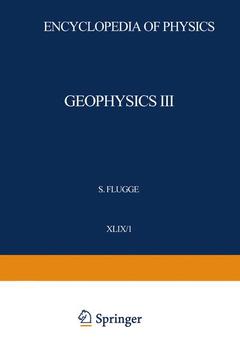Geophysics III / Geophysik III, Softcover reprint of the original 1st ed. 1966 Part I / Teil I Geophysik / Geophysics Series
Langue : Anglais
Auteur : Bartels Julius

0 apparent decrease from the 56° - 58° zone to the 58° -60 zone is due to the lack of data in that region. The lower diagrams seem to indicate that the number of auroras seen in the northermost region (58° -60°) varies relatively little throughout the year, but at lower latitudes during equinoctial periods the belt in which overhead auroras are seen becomes, on the average, broad. Such a study must be supplemented in the future, particularly in the regions to the north of gm lat. 58°, by all-sky camera data. d) Sunspot cycle. It has long been suggested that the main belt of auroras contracts during periods of low sunspot number; and conversely, at times of large sunspot number, the radius of the main belt is enlarged, moving towards lower gm latitudes. Observing auroras at a station to the south of the (northern) auroral zone, the appearance frequency of auroras increases with increase of the sunspot number (d. MEINEL, NEGAARD and CHAMBERLAIN 1954 [50J; see also Sect. 32a and Fig. 51). However, no detailed study of the sunspot cycle variation of the auroral distribution has yet been made in any systematic way. It is expected that iso auroral diagrams will be constructed from data obtained during the I QSY, which will enable us to compare them with the IGY isoauroral diagrams, such as that produced by FELDSTEIN and SOLOMATINA (1960 [18J). SO far, the information available on this subject is fragmentary.
The Aurora.- I. The geographical distribution of the aurora.- II. The auroral forms.- A. The bands.- B. The surfaces.- III. The development of auroral displays.- A. The typical displays seen at a single station.- B. Dynamics of the auroral displays.- C. Typical displays on a continental and on a planetary scale.- IV. The auroras and magnetic storms.- V. Radio studies of the aurora.- VI. Auroral particles and the radiation belts.- A. Motions of charged particles in a dipole field.- B. Balloon observations of auroral particles.- C. Rocket observations of auroral particles.- D. Satellite observations of auroral particles.- VII. The auroral spectrum.- A. Description and analysis of the auroral spectrum.- B. The production of the auroral spectrum.- C. Special types of aurora.- D. Upper atmospheric temperatures inferred from auroral spectra.- VIII. Theories of the aurora.- A. Historical reviews.- B. The geomagnetic field bounded by the solar plasma.- C. The ring current.- D. The formulation of the problem.- E. Present theories of the aurora.- References.- Time-Variations of Cosmic Rays.- First part: Results up to the International Geophysical Year.- A. Methods of observation.- B. Atmospheric effects.- I. Barometer effects.- II. ?-Meson decay effects and seasonal variations.- C. Diurnal variations.- I. Solar diurnal variations.- II. Sidereal diurnal variation.- D. World-wide variations.- I. Variations associated with magnetic storms.- II. Geomagnetic activity effects.- III. Variation with sunspot cycle.- IV. 27-day variations.- E. Solar flare effects.- I. Large increases of cosmic-ray intensity associated with solar flares.- II. Expected geographical distribution of solar-flare increases if these come from the sun.- F. Summary of results up to the Geophysical Year.- Second part: Results obtained in the International Geophysical Year and afterwards.- G. Solar cycle variations.- I. Results from ionization chambers and neutron monitors.- II. Results from high altitude observations.- H. Forbush decreases.- I. Results from continuous monitors.- II. Results from satellites and space probes.- I. Solar flare effects.- I. Results from ground level monitors.- II. Results from other methods of detection.- References.- Magnetic Properties of Rocks and Minerals.- I. Magnetism of rock-forming minerals.- II. Magnetic properties of assemblage of small grains of ferrimagnetic minerals.- III. Remanent magnetism of rocks.- References.- Sachverzeichnis (Deutsch-Englisch).- Subject-Index (English-German).
Date de parution : 01-1966
Date de parution : 03-2012
Ouvrage de 316 p.
17x24.4 cm
Disponible chez l'éditeur (délai d'approvisionnement : 15 jours).
Prix indicatif 105,49 €
Ajouter au panierMots-clés :
© 2024 LAVOISIER S.A.S.



